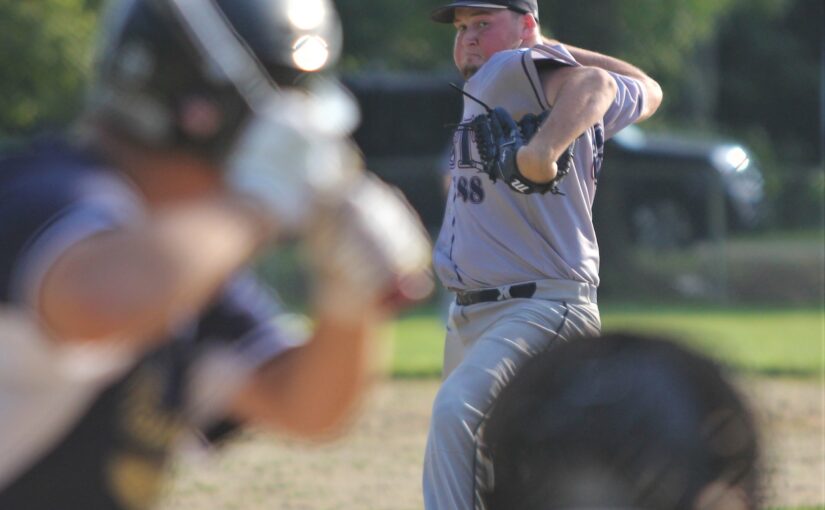Baseball: Mastering first-and-third defenses

Your team defense is critical in forcing the opposition to earn what it scores and not allowing anything more.
One area that constantly needs your attention as a coach is your defense when runners are on first and third, so that all players on the field (infield and outfield) understand their role during different baserunning situations.The most important aspect of a first-and-third defense is understanding the game situation. The number of outs, the score, the speed of the runners and the arm strength of the players involved are the elements the coach evaluates before the pitch. If the defense executes properly, the offense seldom scores. After getting the defensive sign from the coach, the catcher puts on the specific first-and-third defense.
The shortstop usually is assigned to cover second base because he normally has the best arm. The second baseman covers second base in certain situations if his arm is strong enough.
Second baseman as cutoff
In this first-and-third defense, the shortstop covers the bag and the second baseman becomes the cutoff man (10 feet in front of the base).
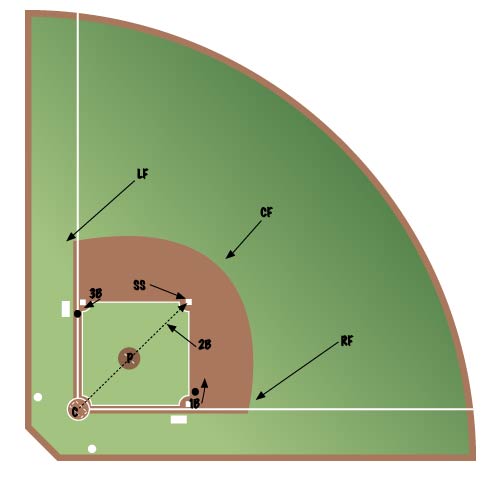
DIAGRAM 1: When the runner from first breaks, the catcher checks third base to see if the third baseman has his hands up. If the third baseman sees the runner off the base too far, he raises both hands over his head as he breaks to the base to signal the catcher to throw the ball to third. The third baseman uses this signal, because the catcher cannot accurately judge the runners distance from third base. If the third baseman’s hands aren’t up, the catcher throws through to second base.
The second baseman must read the runner at third base. If the runner breaks, he has the option to cut the ball and throw it home. If the runner hasn’t broken for home by the time the ball is in the cutoff position, the second baseman fakes a cut by slamming his fist into his glove to freeze the runner at third base. The shortstop covers second base and prepares to tag the runner if the ball goes through to the base. If the runner at third base breaks late, the shortstop can relay the ball to home.
The pitcher fakes a cut on the catcher’s throw to second base in an attempt to confuse the runner at third base. After a fake cut, the pitcher breaks to back up home plate via the first-base line. The left fielder backs up a possible throw to third base from the catcher, while the center fielder backs up the possible throw to second base from the catcher. The right fielder backs up a possible rundown between first and second. The first baseman trails the runner to second base.
Throw through to second base
When throwing through to second base, the catcher again tries to freeze the runner at third by checking the third baseman to see if his hands are up. If they are up, he throws to third. If not, he throws to the shortstop covering second base, who is one step in front of the bag squared to home plate.
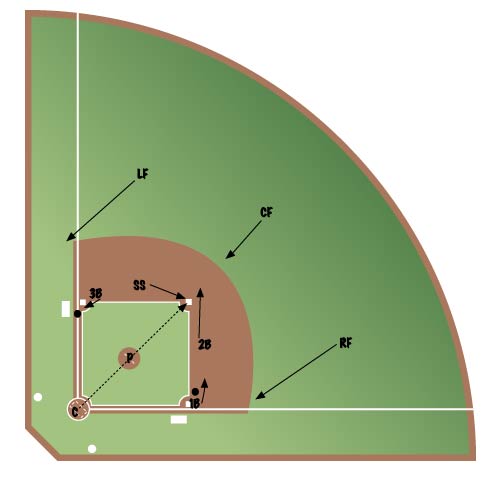
DIAGRAM 2: On the throw, the second baseman backs up second base. If the runner on third breaks for the plate, the shortstop charges hard straight toward the plate to cut off the ball. After chopping his feet for a couple of steps to get on balance, the shortstop catches the ball and throws to the catcher.
If the runner on third doesn’t break for the plate, the shortstop stays on the bag and tags out the runner coming from first base. If the runner on first base has second base stolen, the shortstop has the option to charge in and cut the ball off to avoid a collision with a sliding runner.
The pitcher fakes a cut on the catcher’s throw to second base to confuse the runner at third. After a fake cut, the pitcher breaks to back up home plate via the first-base line. The left fielder backs up a possible throw from the catcher to third while the center fielder backs up a possible throw from the catcher to second base. The right fielder backs up a possible rundown between first and second. The first baseman trails the runner to second base.
Straight to shortstop
When you want to keep the runner on third base from scoring after the ball passes the batter, have a throw go straight to the shortstop, who is charging hard toward home.
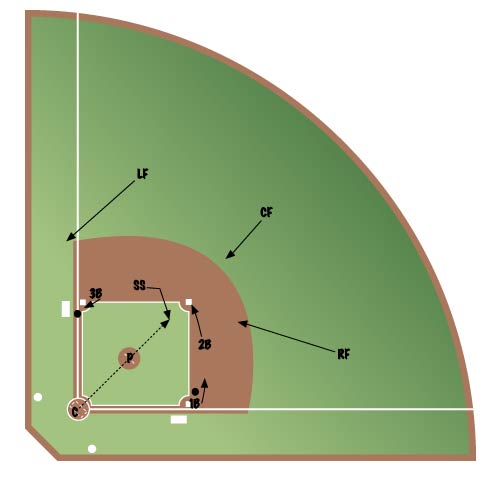
DIAGRAM 3: In this instance, the shortstop takes two steps toward second base, then charges hard toward home plate. The catcher throws straight to the shortstop without looking the runner back at third base. The second baseman covers second base after the ball passes the batter while the first baseman trails the runner from first base to a position midway between first and second. The third baseman covers third base and lets the shortstop and catcher know when the runner breaks for home.
He does this by yelling, “Four! Four!”
The shortstop throws the ball back to home plate after he catches it, or he may possibly backdoor the runner at third base. The pitcher backs up home via the first-base line after he pitches to the plate. The left fielder backs up third base for a possible throw from the catcher. The center fielder backs up the shortstop on a throw from the catcher. The right fielder backs up a possible rundown between second base and third base.
The defense concedes second base to the offensive team.
Throw to pitcher
When you decide to throw directly back to the pitcher, here are the player movements.
The shortstop covers second base and the second baseman moves to a cutoff position 10 feet in front of second base.
Without glancing at the runner on third, the catcher throws the ball high to the pitcher as if he’s throwing to second base. The pitcher cuts off the ball and checks the runner at third base. If there’s no play at third, the pitcher looks to second base. If the runner is caught between first and second, he throws to the shortstop covering second base or to the second baseman, who is now 15 feet up the base line, depending on the runners position.
The shortstop or second baseman yells, “Ball!” indicating to the pitcher who should receive the throw. The other middle infielder drops to a knee and points to the teammate. Once the infielder who received the throw checks the runner at third base, he shuffles (not sprints) the runner back to first. He listens for a call from the third baseman if the runner from third breaks to the plate.
The pitcher covers first base once he gives up the ball. The left fielder backs up third base in foul territory. The center fielder backs up second base and the right fielder backs up the second baseman’s position.
Ball fake & throw to third
To prevent the runner from third from scoring, you sometimes must concede second base to the runner.
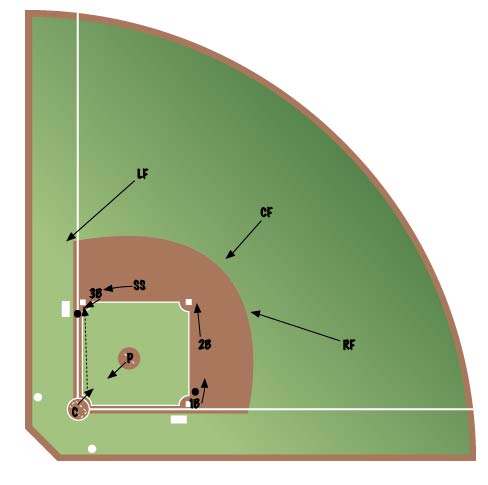
DIAGRAM 5: After the pitch passes the hitter, the third baseman covers third base. The shortstop back up third base and the second baseman covers second. The first baseman trails the runner to second base.
The catcher comes out and gives a good arm fake to second base, making sure he clears and goes beyond home plate, then he throws directly to third base. The pitcher backs up home via the first-base line after he pitches to the plate. The left fielder backs up the catcher’s throw to third. The center fielder backs up a possible throw from the catcher to second. The right fielder backs up a possible throw to second base from third base.
Forced-balk defense
The forced-balk defense is the only first-and-third defense not put on by the catcher. The defense is a reaction to the offensive team sending the runner from first base to second before the pitch to the plate.
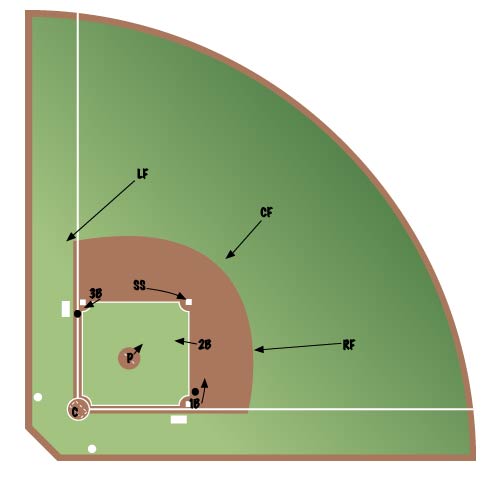
DIAGRAM 6: The pitcher steps off the rubber and freezes the runner at third base by turning directly to third and checking the runner at the bag. If the runner is too far off, he throws to the third baseman. If the runner isnt too far off, the pitcher throws the ball to the second baseman, who comes straight up to the inside of the base line, approximately 15 feet from second base. The pitcher then goes to back up home by way of the third-base line. The third baseman covers third and alerts the infielders if the runner breaks to home by yelling, “Four! Four!” The shortstop covers second base. The second baseman comes straight up into the base line to receive the throw from the pitcher. The first baseman trails the runner to second base.
When the second baseman receives the throw from the pitcher, he checks the runner at third base and begins to shuffle the baserunner back to first base. If the baserunner at third breaks to the plate, the third baseman yells, “Four! Four!” and the second baseman turns and throws to the catcher.
The first baseman calls for the ball when he knows he can catch the ball and tag the runner out. He is then ready to throw home should the runner at third break for the plate. The first baseman needs to avoid running with the ball toward second base.
If the pitcher is late stepping off the mound, the second baseman goes to a knee and points to second base. This signals the pitcher to throw the ball to the shortstop, who is covering second base. The left fielder backs up third base for a possible rundown. The center fielder backs up second base for a possible rundown between second and third. The right fielder backs up the throw to second base from the pitcher.

